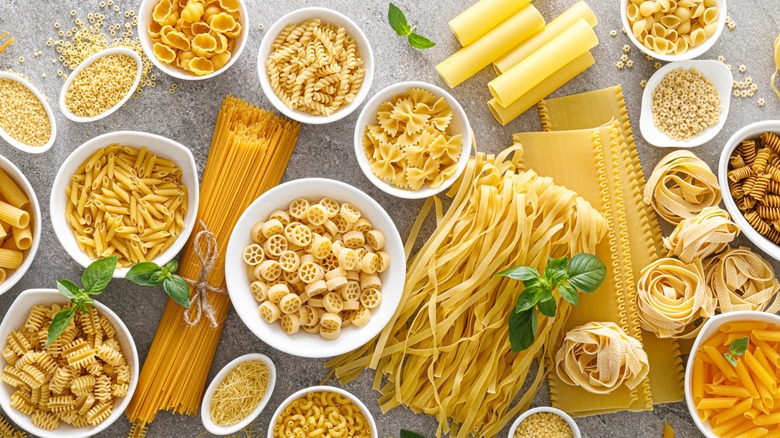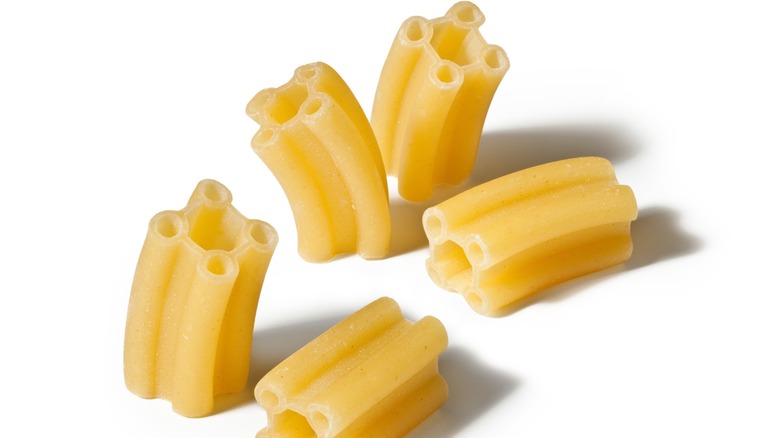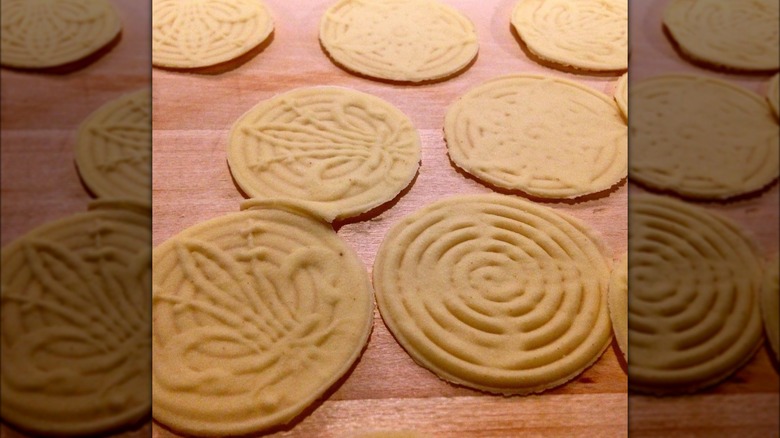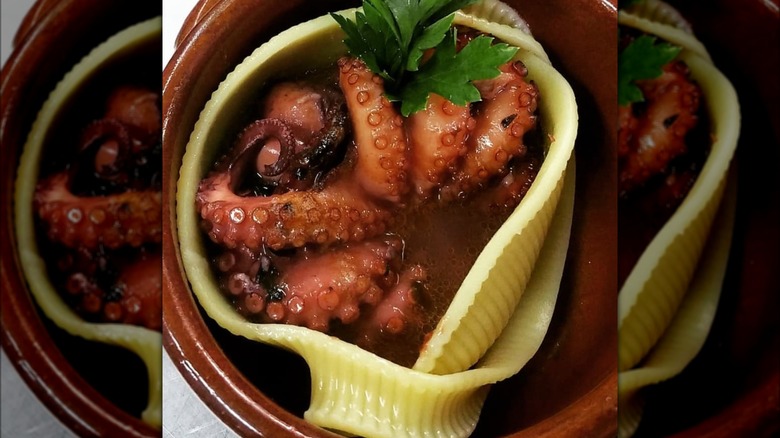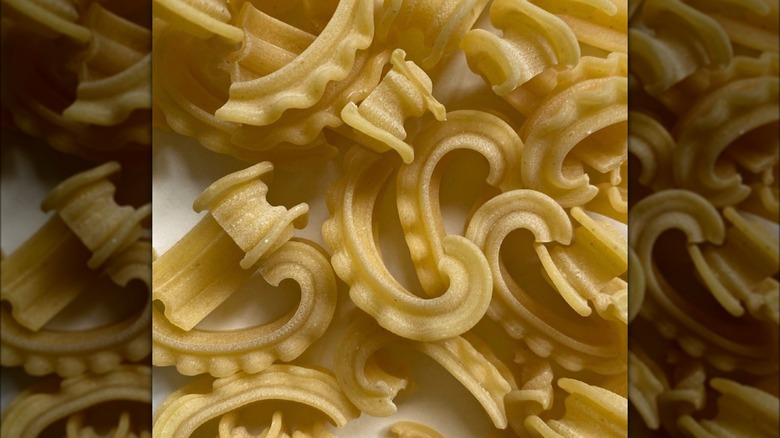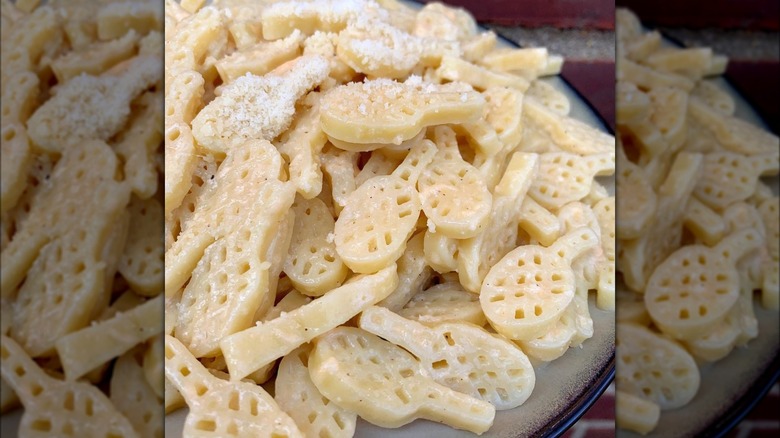5 Obscure Pasta Shapes With Fascinating Backstories
Italy and pasta go hand in hand. Pasta has been a central staple in the kitchens of the Mediterranean peninsula for centuries, if not millennia. Indeed, the practice of mixing then drying flour and water can be dated back to the days of the Etruscans between the 8th and 3rd centuries BCE. The more primitive forms of pasta would be nigh unrecognizable as such today, and Italian pasta has taken influence from East Asian and Arab practices over the course of its storied history. In other words, Italian pasta is less of an invention and more of a cultural evolution. And as pasta developed in Italy and became integral to the country's way of life, so too did new pasta shapes develop over the years.
There are reportedly hundreds of unique pasta shapes spread throughout Italy, with some reporting over 350 unique forms (though a solid number is, of course, hard to obtain). Some have universal recognition, like spaghetti or penne, while others are much more obscure and region-centric. And others still are fresh on the pasta scene, having only been invented recently. Here are some fascinating pasta shapes that you may not have heard of, along with the often hazy stories of how they came to be.
Cinque buchi was made by mistake
The strange geometric pasta shape known as cinque buchi supposedly dates back over 1,000 years, when a Catanian pasta maker was given the task of creating large quantities of macaroni for a noble family. However, something went wrong during the pasta making, which resulted in the strange joined tubes that would become known as cinque buchi. Though a purported accident, the shape gained the admiration of the people and became associated with the Carnival season in Catania.
As a result, cinque buchi — literally meaning "five holes" – is sometimes also called "carnival pasta." The four corner holes and larger central hole provide a ton of surface area for sauces and seasonings to cling on. Typically, cinque buchi is made into a dish consisting of diced pork and/or sausage, tomatoes, and other seasoning ingredients to make a savory, meaty pasta dish fit for Carnival. Though cinque buchi is hard to find outside of Catania and away from the Carnival season, "Sporkful" podcast host Dan Pashman and pasta company Sfoglini have recently released a ridged alternative to the obscure shape, dubbed "quattrotini."
Corzetti del Levante was a status symbol for Renaissance nobles
The shape of corzetti del Levante catches the eye immediately with its flat, circular form and use of decorative embossments right on the pasta itself. Though certainly a fascinating aesthetic distinction from your regular pasta noodles, these embossments aren't just decorative — they also give the pasta more surface area, helping sauce cling onto each little floury disc. Each piece is about 1.5 inches in diameter, though it's reasonable to assume that different households may have made corzetti del Levante in varying sizes over the many years of the shape's existence. It should also be noted that there are two distinct forms of corzetti in its native Liguria: the stamped corzetti del Levante and "corzetti valpolceveraschi," which doesn't stamp the disc but twists it instead, forming a sort of figure of 8.
There's some speculation pertaining to the history of corzetti del Levante, with possible links to the "corzetto," a round Genovese coin from around the 14th century. It could also link back to the Latin word "crux," meaning "cross," which used to be embossed on the faces of corzetti del Levante (and which also appeared on the "corzetto" coin, hence its name). Either way, the tradition of imprinting designs onto these circles was alive during the Renaissance, when well-to-do families would have their sigils/coats of arms stamped onto their corzetti. So if you want to make a statement next time you host a dinner party, just make your own corzetti del Levante stamp and serve up some truly one-of-a-kind pasta!
Caccavelle are massive pasta shells
You're probably familiar with pasta shells such as conchiglie. But what makes caccavelle immediately stand out from the rest of the pasta shell family is its gargantuan size. Essentially a humongous hollow bowl, caccavelle clocks in at about 4 inches in diameter and about 6 inches in height, making it the largest pasta shell in the world.
Meaning "pots" in the regional dialect of Naples, which is where this pasta originates, caccavelle was only introduced into the culinary scene in 2009 by the Gragnano Pasta Factory, an artisanal pasta-making company. They're sold in packs of four shells, and they can easily act as a veritable pasta bowl for your saucy mixtures. Recipes abound suggesting what to serve in these massive shells, including meaty ragus, fresh seafood, and creamy spinach-ricotta blends. Imagine using the same recipes you'd use for stuffed pastas (think cannelloni), except your concoction rests in an edible dish!
Cascatelli is a modern-day invention
Pasta is an ever-evolving art, with new pasta shapes being created to this day. There's perhaps no greater testament to this sentiment than cascatelli, the first original pasta shape created by the collaborative efforts of Dan Pashman and Sfoglini (the same team behind quattrotini, the new riff on cinque buchi). It was officially released in 2021, after about three years of painstaking development to create the ideal pasta shape. In creating cascatelli, Pashman sought to find the perfect shape for his three distinguishing features of pasta quality, which he dubs "sauceability" (the ability for sauce to mingle with the pasta), "forkability" (the ease with which you can either stab or scoop up the pasta with your fork), and "toothsinkability" (the textural satisfaction you get from biting into the pasta).
Cascatelli's shape, then, can be seen with all three of these qualities in mind. Its unique, asymmetrical waterfall-like shape (from which the name "cascatelli" is derived) makes for great sauce retention and a dynamic texture. Whether using this pasta as a simple swap for your mac and cheese or trying it out in different sauces (or even in salads), you've truly never tried anything like cascatelli before.
Racchette is a pasta mystery
Specifically shaped pastas aren't a new concept. We already have stelline (star-shaped pasta) and rotelle (pasta shaped like wagon/bicycle wheels) to name a couple. But perhaps no pasta is as oddly specific in its shape than racchette -– which, if you couldn't guess by its name, comes in the shape of teeny-tiny tennis rackets. While definitely a fun, kitschy shape (especially for any tennis-loving friends/family of yours), the litany of small holes in the pasta will effectively act as a net for trapping any sauce that it encounters. Whether you serve it with an all-purpose tomato sauce, a cheese/cream base, or even a herbaceous pesto, each mini racket should give you a full serving of flavor.
Racchette is an entirely modern creation, and it's an original invention by the De Cecco pasta company, primarily based in Fara San Martino in Italy. And while many pastas can be made more interesting from their rich backstories, it's the absence of any kind of origin that gives racchette an added air of intrigue. Besides claiming racchette as an original invention, De Cecco has not publicly elaborated on why they chose to make a tennis racket-shaped noodle. It'd be fair to assume upon first glance that it was made in collaboration with a particular brand or player, but there's no evidence to suggest any such thing. It seems then that De Cecco simply wanted to give racchette a shot and created a bit of a racket with this ace of a shape.
